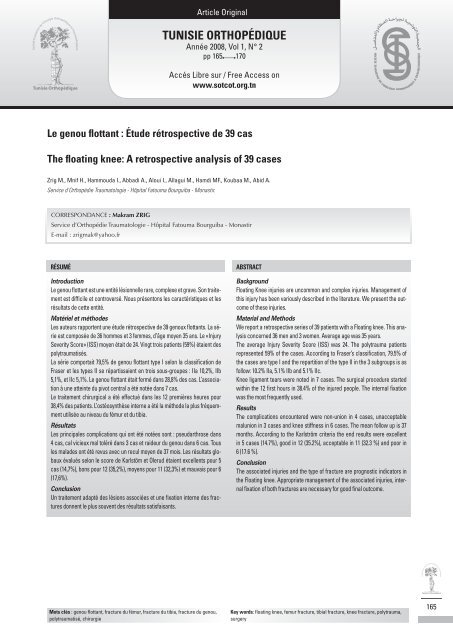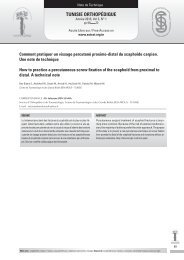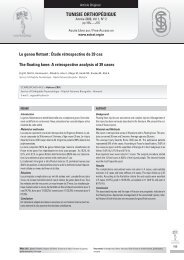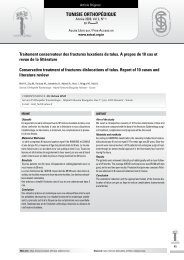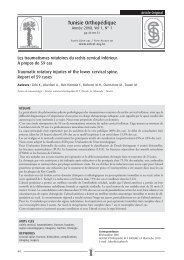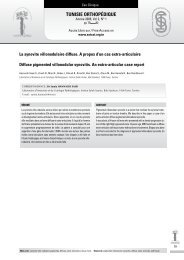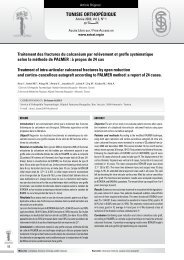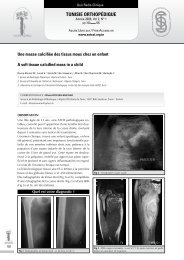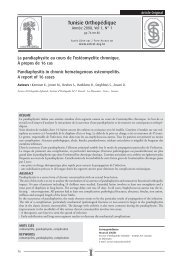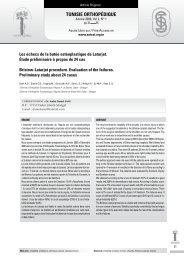Article OriginalTunisie OrThOpédiqueAnnée 2008, Vol 1, N° 2pp 165 170Accés Libre sur / Free Access onwww.<strong>sotcot</strong>.org.tnLe genou flottant : étu<strong>de</strong> rétrospective <strong>de</strong> 39 casThe floating knee: A retrospective analysis of 39 casesZrig M., Mnif H., Hammouda I., Abbadi A., Aloui I., Al<strong>la</strong>gui M., Hamdi MF., Koubaa M., Abid A.Service d’Orthopédie Traumatologie - Hôpital Fatouma Bourguiba - Monastir.CORRESPONDANCE : makram ZriGService d’Orthopédie Traumatologie - Hôpital Fatouma Bourguiba - MonastirE-mail : zrigmak@yahoo.frrésuméIntroductionLe genou flottant est une entité lésionnelle rare, complexe et grave. Son traitementest difficile et controversé. Nous présentons les caractéristiques et lesrésultats <strong>de</strong> cette entité.Matériel et métho<strong>de</strong>sLes auteurs rapportent une étu<strong>de</strong> rétrospective <strong>de</strong> 39 genoux flottants. La sérieest composée <strong>de</strong> 36 hommes et 3 femmes, d’âge moyen 35 ans. Le «InjurySeverity Score» (ISS) moyen était <strong>de</strong> 24. Vingt trois patients (59%) étaient <strong>de</strong>spolytraumatisés.La série comportait 79,5% <strong>de</strong> genou flottant type I selon <strong>la</strong> c<strong>la</strong>ssification <strong>de</strong>Fraser et les types II se répartissaient en trois sous-groupes : IIa 10,2%, IIb5,1%, et IIc 5,1%. Le genou flottant était fermé dans 28,8% <strong>de</strong>s cas. L’associationà une atteinte du pivot central a été notée dans 7 cas.Le traitement chirurgical a été effectué dans les 12 premières heures <strong>pour</strong>38,4% <strong>de</strong>s patients. L’ostéosynthèse interne a été <strong>la</strong> métho<strong>de</strong> <strong>la</strong> plus fréquemmentutilisée au niveau du fémur et du tibia.RésultatsLes principales complications <strong>qui</strong> ont été notées sont : pseudarthrose dans4 cas, cal vicieux mal toléré dans 3 cas et rai<strong>de</strong>ur du genou dans 6 cas. Tousles ma<strong>la</strong><strong>de</strong>s ont été revus avec un recul moyen <strong>de</strong> 37 mois. Les résultats globauxévalués selon le score <strong>de</strong> Karlstöm et Olerud étaient excellents <strong>pour</strong> 5cas (14,7%), bons <strong>pour</strong> 12 (35,2%), moyens <strong>pour</strong> 11 (32,3%) et mauvais <strong>pour</strong> 6(17,6%).ConclusionUn traitement adapté <strong>de</strong>s lésions associées et une fixation interne <strong>de</strong>s fracturesdonnent le plus souvent <strong>de</strong>s résultats satisfaisants.ABsTrAcTBackgroundFloating Knee injuries are uncommon and complex injuries. Management ofthis injury has been variously <strong>de</strong>scribed in the literature. We present the outcomeof these injuries.Material and MethodsWe report a retrospective series of 39 patients with a Floating knee. This analysisconcerned 36 men and 3 women. Average age was 35 years.The average Injury Severity Score (ISS) was 24. The polytrauma patientsrepresented 59% of the cases. According to Fraser’s c<strong>la</strong>ssification, 79.5% ofthe cases are type I and the repartition of the type II in the 3 subgroups is asfollow: 10.2% IIa, 5.1% IIb and 5.1% IIc.Knee ligament tears were noted in 7 cases. The surgical procedure startedwithin the 12 first hours in 38.4% of the injured people. The internal fixationwas the most frequently used.ResultsThe complications encountered were non-union in 4 cases, unacceptablemalunion in 3 cases and knee stiffness in 6 cases. The mean follow up is 37months. According to the Karlström criteria the end results were excellentin 5 cases (14.7%), good in 12 (35.2%), acceptable in 11 (32.3 %) and poor in6 (17.6 %).ConclusionThe associated injuries and the type of fracture are prognostic indicators inthe Floating knee. Appropriate management of the associated injuries, internalfixation of both fractures are necessary for good final outcome.mots clés : genou flottant, fracture du fémur, fracture du tibia, fracture du genou,polytraumatisé, chirurgieKey words: floating knee, femur fracture, tibial fracture, knee fracture, polytrauma,surgery165
Tun Orthop 2008, Vol 1, N° 2Zrig M et al.i. introduCtionLe genou flottant est une entité lésionnelle décrite<strong>pour</strong> <strong>la</strong> première fois en 1975 par B<strong>la</strong>keet McBri<strong>de</strong> [1]. Il s’agit <strong>de</strong> l’association d’unefracture du fémur à une fracture homo<strong>la</strong>téraledu tibia. Elle survient <strong>pour</strong> <strong>de</strong>s traumatismes àhaute énergie et est généralement accompagnéed’autres lésions potentiellement vitales. C’est unelésion grave ; caractérisée par <strong>la</strong> difficulté <strong>de</strong> sontraitement et son mauvais pronostic.Peu <strong>de</strong> publications ont été consacrées à ce sujet. Nousen présentons 39 nouveaux cas. A partir <strong>de</strong> l’analyse<strong>de</strong> cette série et <strong>de</strong> <strong>la</strong> littérature, nous essayons <strong>de</strong> dégagerles caractéristiques et le pronostic <strong>de</strong> cette entité.La gravité <strong>de</strong> ces lésions a été évaluée en utilisantl’ISS (Injury Severity Score) défini par Baker [2].Le score moyen était <strong>de</strong> 24 [16, 52]. Vingt troispatients (59%) avaient un score supérieur à 18constituant par définition <strong>de</strong>s polytraumatisés.La fracture du fémur était diaphysaire dans 76,9%<strong>de</strong>s cas et articu<strong>la</strong>ire dans 10,2% <strong>de</strong>s cas. La fracturedu tibia était diaphysaire dans 74,3% <strong>de</strong>s caset articu<strong>la</strong>ire dans 15,3% <strong>de</strong>s cas. Nous avonsadopté <strong>la</strong> c<strong>la</strong>ssification <strong>de</strong> Fraser [3] <strong>qui</strong> différencieles fractures selon leurs composantes articu<strong>la</strong>ires(Type I) ou non (Type II) (Fig 1). Les fracturesType I étaient <strong>de</strong> loin les plus fréquentes : 79,5%.Les Type IIA (fracture articu<strong>la</strong>ire du tibia), Type IIB(fracture articu<strong>la</strong>ire du fémur) et Type IIC (fracturearticu<strong>la</strong>ire du fémur et du tibia) représentaientrespectivement 10,2%, 5,1% et 5,1%.166ii. matériel et métho<strong>de</strong>sIl s’agit d’une étu<strong>de</strong> rétrospective <strong>de</strong> 39 genouxflottants pris en charge entre 1990 et 2006 dans leservice d’Orthopédie à l’Hôpital Universitaire <strong>de</strong>Monastir. Cette série a intéressé <strong>de</strong>s adultes présentantune fracture du fémur et du tibia homo<strong>la</strong>téralsituée entre <strong>la</strong> ligne intertrochantérienne etle tiers distal du tibia, non amputé et non décédélors <strong>de</strong> <strong>la</strong> prise en charge initiale.La moyenne d’âge était <strong>de</strong> 35 ans (extrêmes : 17 et75 ans). La répartition par sexe était à majorité masculineavec 36 hommes <strong>pour</strong> 3 femmes. La fracturea intéressé le côté droit dans 15 cas et le côté gauchedans 24 cas. Ces fractures faisaient suite à un acci<strong>de</strong>nt<strong>de</strong> <strong>la</strong> voie publique dans 36 cas (acci<strong>de</strong>nt <strong>de</strong>s 2roues dans 24 cas), à un acci<strong>de</strong>nt domestique dans2 cas et à un acci<strong>de</strong>nt <strong>de</strong> travail dans 1 cas.L’association à d’autres lésions a été fréquente(Tableau 1).tableau 1 : Les différentes lésions associéeslésions associéesTraumatisme crânien sévère 13Traumatisme crânien bénin 12Traumatisme thoracique 5Traumatisme abdominal 4Traumatisme du bassin 2Traumatisme du rachis 1Traumatisme osseux du côté homo<strong>la</strong>téral 10Traumatisme osseux du côté contro<strong>la</strong>téral 8Traumatisme facial 6nombre <strong>de</strong> casFigure 1 : C<strong>la</strong>ssification <strong>de</strong> Fraser.Le genou flottant était fermé dans 28,2% <strong>de</strong>s cas.La fracture fémorale était ouverte dans 25,6% <strong>de</strong>scas. La fracture tibiale était ouverte dans 64,1%<strong>de</strong>s cas. Une seule atteinte du sciatique poplitéexterne a été notée. Aucune atteinte vascu<strong>la</strong>iren’a été pas retrouvée, cependant un syndrome <strong>de</strong>loge a été noté dans <strong>de</strong>ux cas.Une réanimation première a été nécessaire dans35,8% <strong>de</strong>s cas. Le traitement chirurgical a été réalisédans un dé<strong>la</strong>i <strong>de</strong> 12 heurs dans 38,4% <strong>de</strong>scas. L’ostéosynthèse <strong>de</strong>s <strong>de</strong>ux foyers a été réaliséeau cours du même temps opératoire dans 80,5%<strong>de</strong>s cas. Le temps opératoire moyen a été <strong>de</strong> 205minutes (155 à 410 minutes).Les fractures du fémur ont été traitées par enclouagecentromédul<strong>la</strong>ire dans 17 cas, par <strong>la</strong>mep<strong>la</strong>que condylienne dans 7 cas, par clou p<strong>la</strong>quedans 6 cas et par p<strong>la</strong>que vissée dans 5 cas. Quatrefractures ouvertes <strong>de</strong> type III ont été traitées parfixateur externe (Fig 2).Figures 2 a, b : Genou flottant type I (c<strong>la</strong>ssification <strong>de</strong> Fraser).
- Page 2 and 3:
Tunisie OrThOpédiqueOrgane Offi ci
- Page 4 and 5:
SommaireTunisie OrThOpédiqueAnnée
- Page 6 and 7:
ÉditorialTunisie OrThOpédiqueAnn
- Page 8 and 9:
Orthopédie signifie, d’après le
- Page 10: Conférence d’ActualitéTunisie O
- Page 14: les chances de mise en évidence de
- Page 19: Tun Orthop 2008, Vol 1, N° 2124Ben
- Page 22 and 23: • Douleurs articulaires exacerbé
- Page 24 and 25: d’une antibiothérapie par voie o
- Page 28 and 29: 57) Yagupsky P, Press J. Use of the
- Page 30 and 31: i. teChnique ChirurGiCaleL’interv
- Page 32: Article OriginalTunisie OrThOpédiq
- Page 35: Tun Orthop 2008, Vol 1, N° 2140Zar
- Page 38 and 39: Article OriginalTunisie OrThOpédiq
- Page 40 and 41: Résultats de l’ostéotomie tibia
- Page 42 and 43: Résultats de l’ostéotomie tibia
- Page 44 and 45: Résultats de l’ostéotomie tibia
- Page 46 and 47: i. introduCtionLe traitement de l
- Page 48 and 49: C- Résultats cliniquesAu dernier r
- Page 50 and 51: elation entre la position de la but
- Page 52 and 53: i. introduCtionLa dysplasie cotylo
- Page 54 and 55: Résultats du traitement de la dysp
- Page 56 and 57: maintiendra tout au long de la croi
- Page 59: écrire ou périrécrire pour s’
- Page 65 and 66: Tun Orthop 2008, Vol 1, N° 2170Zri
- Page 67 and 68: Tun Orthop 2008, Vol 1, N° 2172Bou
- Page 69 and 70: Tun Orthop 2008, Vol 1, N° 2Bouatt
- Page 72 and 73: Hardouin P, Jeanfils J et al. : Gen
- Page 74 and 75: i. introduCtionii. matériel et mé
- Page 76 and 77: partiellement ou, dans de rare cas,
- Page 78 and 79: Note TechniqueTunisie OrThOpédique
- Page 80 and 81: obtenue à un mois post-opératoire
- Page 82 and 83: Cas CliniqueTunisie OrThOpédiqueAn
- Page 84 and 85: L’ostéosarcome intra-médullaire
- Page 87 and 88: Tun Orthop 2008, Vol 1, N° 2Ayadi
- Page 89 and 90: Tun Orthop 2008, Vol 1, N° 2Ayadi
- Page 91 and 92: Tun Orthop 2008, Vol 1, N° 2Mnif H
- Page 93 and 94: Tun Orthop 2008, Vol 1, N° 2Mnif H
- Page 95 and 96: Tun Orthop 2008, Vol 1, N° 2Kandar
- Page 97 and 98: Cas CliniqueTunisie OrThOpédiqueAn
- Page 99 and 100: Tun Orthop 2008, Vol 1, N° 2204Gua
- Page 101 and 102: Cas CliniqueTunisie OrThOpédiqueAn
- Page 103 and 104: Tun Orthop 2008, Vol 1, N° 2208Say
- Page 105 and 106: Quiz Radio-CliniqueTunisie OrThOpé
- Page 107 and 108: Tun Orthop 2008, Vol 1, N° 2Louati
- Page 109 and 110: Articles ImmigrésTunisie OrThOpéd
- Page 111 and 112:
Tun Orthop 2008, Vol 1, N° 2Articl
- Page 113 and 114:
Tun Orthop 2008, Vol 1, N° 2Articl
- Page 115 and 116:
Articles sous MicroscopeTunisie OrT
- Page 117 and 118:
Tun Orthop 2008, Vol 1, N° 2222Art
- Page 119 and 120:
Tun Orthop 2008, Vol 1, N° 2Articl
- Page 121 and 122:
Tun Orthop 2008, Vol 1, N° 2226Art
- Page 123 and 124:
Tun Orthop 2008, Vol 1, N° 2Articl
- Page 125:
Recommandations aux AuteursTunisie


